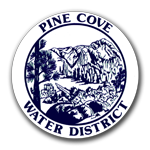Preventing Frozen Pipes
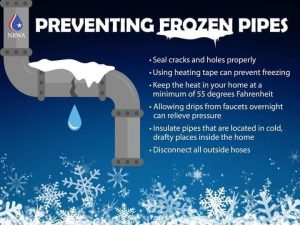
Water Conservation
Archive for Water Conservation

Hello Residents of Pine Cove!
December billing (due January 5, 2023) is going out this week. If you get emailed bills, you should have already received yours.
This months mailed billing included our Winter Newsletter, Evacuation Checklist, and Property Hardening. Click here to view those items.
The bi-monthly minimum is $77.00 for two month billing period, excluding any water usage. Water usage is billed as follows:
$7.00 per thousand gallons from 0 to 7,500 gallons
$9.00 per thousand gallons from 7,500 to 15,000 gallons
$11.00 per thousand gallons over 15,000
Water bills are mailed around the 1st of the Billing Month (even months). All bills are due and payable by the 1st of the following month (odd months). Any bill not paid by the due date will be termed delinquent and subject to a $15.00 late fee and/or termination. If shut off, a reconnect fee of $75.00 will be charged, in addition to the current amount due, to re-establish service.
There are several ways to pay your bill. ACH Auto Draft is a free service; the payment is automatically taken out of your bank account (filled out form required). You can log on to your account online, and pay with a Visa/Mastercard/Discover, or E-check. To register your account online, you will need your account number, and the Municipality Code which is PineCoveWDCA. Go to www.pcwd.org and click the “Billing” tab and the Payment option link. Next, click on the www.ub-pay.com link and register your account from there. You can come into the office and pay by check, cash, or card (one person at a time). Call with a credit/debit card (Please note that there is a convenience fee of $3.00 per hundred dollars charged if using a credit card). Drop payments thru the slot on the front door or mail a check or money order.
Posted in: Around the District, Community, Company News, Compost, Customer Infomation, Emergencies, Fire, Freebies, From the Office, Mountain Communities Fire Safe Council, Mulch, Pets and Animals, Pine Cove Water District, Rain Barrels, Upcoming Events, Water Bills, Water Conservation, Wood chips
Leave a Comment (0) →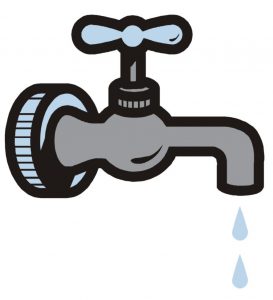
DO wash full loads of laundry and dishes ONLY to spread out wash cycles.
DON’T hand wash your car. Instead, take it to a car wash, where recycled water is used.
DO look for leaky faucets and running toilets. Repairing a dripping faucet can save up to 150 gallons of water a week.
DON’T leave the sink running while brushing your teeth. Install a bathroom sink aerator to slow the flow of water.
DO purchase water saving shower heads. Or come into our District office, and we will give you a conservation kit for free!
DON’T take long showers. Keeping showers under 5 minutes can save up to 1000 gallons of water per month.
DO store water in the refrigerator instead of letting the tap run for cool water.
DON’T use the toilet as a waste basket!
DO collect water used to rinse fruit or vegetables, and use to to water your plants, both inside and out. 🙂
DON’T keep water conservation tips to yourself! Share, share, share!
DO aim to do at least one thing per day to conserve water.
And ALWAYS turn your customer valve off when leaving your mountain home.
We’re into the second month of the new year and so much has happened. Here are a few highlights.
Office re-opened to foot traffic:
Due to illnesses in the office, we had temporarily closed the office to foot traffic. We are happy to announce that we are fully open once again. We ask that you wear a mask when in the building and if someone is already at our counter that you respectfully wait outside to limit the number of people inside.
Stage II Water Conservation:
As of Tuesday, February 1, 2022 Pine Cove entered into Stage II of Water Conservation.
Stage II is mandatory compliance.
Customers are required to limit irrigation of outdoor plants and gardens to the period between 6pm and 8am daily and stop all water runoff. Customers cannot fill or refill swimming pools except the small amount needed to replace evaporation in already filled pools. Vehicles can only be washed using a bucket and a hose with a shut-off nozzle. Immediate repairs must be made to any and all leaking water lines and faucets in household plumbing and yard piping. Customers must also cease watering native vegetation and unplanted areas for dust control. Restaurants shall only provide drinking water to patrons upon specific request.
If you have any questions or concerns, you may talk to General Manager Jeremy Potter 951-659-2675 or email at jpotter@pcwd.org.
Thank you for your understanding and ongoing efforts to help conserve water.
Billing Charges increased:
Effective 2/1/2022, the bi-monthly minimum will be $77.00 for two month billing period, excluding any water usage. Water usage will be billed as follows:
$7.00 per thousand gallons from 0 to 7,500 gallons
$9.00 per thousand gallons from 7,500 to 15,000 gallons
$11.00 per thousand gallons over 15,000
Special Rates and Charges (Resolution #561)
Normal Customer Requested Turn On or Off; changed from $15 to $20
After Hours customer Requested Turn On or Off; changed from a minimum of $40 to a minimum of $50
Delinquent Turn On/Off; changed from $75 to $90
Transfer Fee; changed from $45 to $60
Where more than one (1) Premises exists or is located on a Parcel, a unit charge of $20.00 will be assessed for each separate Premises in addition to normal water use charges for the Parcel, as prescribed in the Rates Schedule.
Personnel change:
General Manager Jerry Holldber has retired as of 12/31/2021
Jeremy Potter has taken the position as our new General Manager as of 1/1/2022
Chris Dumas has been promoted to Leadman
Jensen Beri has been put on full time / permanent status
Gracie, our official Mouse Patroller has a new home with Kat Garver
And we have welcomed our newest office pet – Mousekewitz; a little chihuahua-mix dog
We hope all is well with you and as always, we are here for any questions or concerns.
Hello Pine Cove Residents.
As of Tuesday, February 1, 2022 Pine Cove will enter into Stage II of Water Conservation.
Stage II is mandatory compliance.
Customers are required to limit irrigation of outdoor plants and gardens to the period between 6pm and 8am daily and stop all water runoff. Customers cannot fill or refill swimming pools except the small amount needed to replace evaporation in already filled pools. Vehicles can only be washed using a bucket and a hose with a shut-off nozzle. Immediate repairs must be made to any and all leaking water lines and faucets in household plumbing and yard piping. Customers must also cease watering native vegetation and unplanted areas for dust control. Restaurants shall only provide drinking water to patrons upon specific request.
If you have any questions or concerns, you may talk to General Manager Jeremy Potter 951-659-2675 or email at jpotter@pcwd.org.
Thank you for your understanding and ongoing efforts to help conserve water.
We are excited to bring back the rain barrels. We have had enough interest to get an initial order started.
If you are still interested in purchasing a rain barrel, please let us know as soon as possible.
The “Ivy” rain barrel is available in black with all components included to start collecting and reusing your rainwater! Price is $76.00 and you will be sent an invoice.
Made in the USA
Dimensions: 42.5”(h) x 22”(w) x 18”(l)
50 gallons
50% recycled plastic
Locking lid
Linking capacity
2 overflow ports
Meets EPA safety standards
Opaque HDPE material – screened inlet
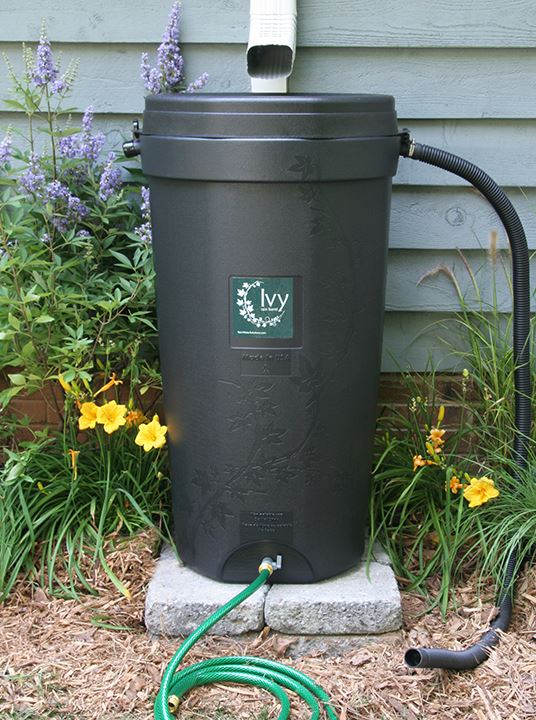
I recently came across this term and wanted to learn more about it. Xeriscaping is a way to landscape with using minimal water.
When searching xeriscaping, I found that there are 7 basic principles:
* Sound landscape planning and design.
* Limitation of turf (commonly referred to as lawn) to appropriate, functional areas.
* Use of water efficient plants.
* Efficient irrigation.
* Soil amendments.
* Use of mulches.
* Appropriate landscape maintenance.
There are many plants that can survive with little to no irrigation. I recommend either having a local expert help with finding the right plants or doing an online search.
The main thing to look for is “drought-resistant plants”.
The ones I found listed on TheSpruce.com are Hens and chicks, Aloe Vera, and Autumn Joy sedum, or “stonecrop”. If you are looking for a little more color, I found that Verbena, Marigold, Lavender, Daffodils, and Iris are low maintenance plants as well.
The LA Times did an article in February 2020 about xeriscaping and why you should try it. They mention that even when plants are labeled as a “California native plant”, there are many different climates in California. In Southern California, we should be look for plants around our Mediterranean climate, similar to central Chile, the Western Cape province of South Africa, and southern and western Australia.
They recommend some of the same principles as I found above such as taking stock of your lawn but also add things like visiting a Southern California botanic garden, nurseries devoted to Caliornia native plants, and The California Native Plant Society’s Calscape database.
I have no doubt that the experts at Idyllwild Community Garden are a great resource to learn more and advise on what plants grow well on our little mountain. Just looking at their website I came across this page that has multiple resources – choosing-what-to-plant.
However you start your spring, we hope it brings you joy!
With the most recent storms, snow and rain have helped increase the amount of ground water that we can pump into our wells. However, it takes a while for the new water to be pumped and processed into clean drinking water so conserving is always a great thing to do to make sure we have continued water in the dry season.
According to energy.gov Americans use between 80-100 gallons of water each day. Where is all of this water going? One of the biggest contributors is the bathroom.
Toilets – Do you know your toilet’s water usage? If it’s an older model, it could be using up to 6 gallons of water per flush. The federal standard is 1.6 gallons per flush. Even low flow toilets need to be looked at for age and leaking*.
Shower – Federal regulations say that showerheads cannot exceed 2.5 gallons of flow per minute. Using a low flow shower head* can help reduce water usage as well as energy/propane from heating.
Bathroom faucets* – If you turn off the water while brushing your teeth*, you can save up to eight gallons of water per day.
*The FREE Water Saving Kit at the PCWD office includes:
Toilet leak detection tables – FDA-certified, non-toxic dye tablets used to detect leaks in toilets.
Earth Massage 1.5 GPM Showerhead – two-setting massage spray showerhead.
Bathroom Faucet 1.0 GPM Aerators – half the flow, twice the power. Commercial grade aerators for the home.
Ask to add in a 3-min sand timer to help with teeth brushing time.
Posted in: Conservation, Freebies, Water Conservation
Leave a Comment (0) →As a Pine Cove resident, you are welcome to our offer of FREE Wood Chip for your Garden.
Our wood chips are from local wood and kept as clean from twigs and leaves as possible.
We have an abundance of wood chips at our Dutch Flats location that you can help yourself to. Please bring your own materials to gather or shovel and haul the wood chips away. If you need a larger load call the office and we can deliver a dump truck load for a delivery charge.
Our regular rate for delivery is $125 but we are having a SPECIAL FOR DECEMBER where you can get a delivery for ONLY $100. Our deliveries are around 9 cubic yards and you just need to indicate where to leave the pile.
If you are planning on gathering a large amount of wood chips on your own, please check in with us at the office first, as we want to be sure there is enough for everyone.
We still have a small amount of compost if you would like that as well. Same pick up or delivery situation; help yourself to the pile at Dutch Flats or call for a delivery at $125 a load.
Pine Cove Water District hours M-F 9am – 12pm, 1 pm-4pm
951-659-2675 or email info@pcwd.org
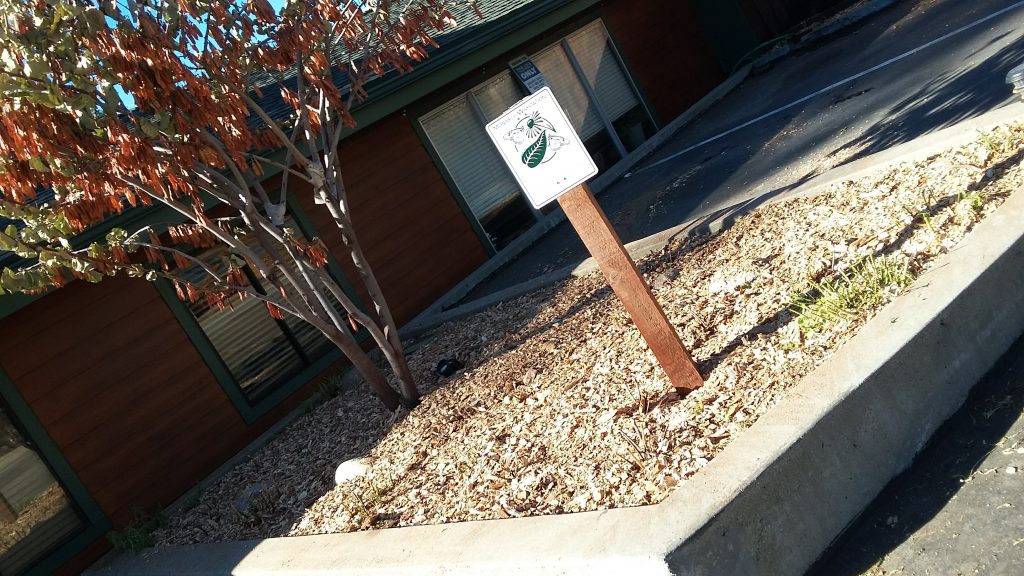
Prepare and protect your home for winter.
Your October 1st mailing included a pamphlet that has all of this information.
Conserve water and always use wisely.
When temperatures begin to lower in the fall, it’s time to get ready for winter. Every winter season, homeowners in mountain communities are at risk of the damage and expense caused by frozen pipes. However, just a few precautions can greatly reduce your risk (and may even help with your winter heating efficiency)!
Disconnect and Drain
Detaching hoses from outdoor faucets allows water to drain from the pipe.
Insulate Pipes or Faucets in Unheated Areas
If you have pipelines in an unheated garage or cold crawl space under the house, wrap the water pipes before temperatures plummet.
Seal Off Access Doors, Air Vents and Cracks
Winter winds whistling through overlooked openings can quickly freeze exposed water pipes. Don’t plug air vents. Your furnace and water heater need proper ventilation.
Find the Master Shutoff
In case of a leak, everyone in the family needs to know where it is and what it does. It’s usually where the water line comes into your house from the street.
Remember, all water that passes through the meter is the homeowner’s responsibility, even water lost due to frozen/broken pipes.
Vacant Home?
Turn Off Your Water!
Homes should have a “customer” shut-off valve just outside the District’s meter box at the street. All homes have a “District” shut off valve before the meter. Before vacating your home, always turn off your water at your customer shut off valve, located next to the District valve. It is not necessary to have the District valve shut off if your customer valve is shut off and operational. Please remember that ONLY authorized District personnel may turn off/on the District water meter shut-off valve. If you need help or can’t locate your customer valve, contact your local District.
Once your water is turned off, open and drain ALL household and irrigation lines. Any trapped water can freeze causing pipes to expand and break. Once all the lines have been drained, it is important to close all household and irrigation lines again before leaving your home.
Keep in mind that maintaining low heat in your home does not necessarily ensure that your pipes will not freeze. This is especially true if you are not a full-time resident. If you have any questions about winterizing or a Customer Shut-Off Valve, please contact your District office.
Pine Cove Water District 951-659-2675
Posted in: Uncategorized, Water Conservation, Weather, Winter, winterizing
Leave a Comment (0) →Pine Cove Water District
24917 Marion Ridge Road • P.O. Box 2296 • Idyllwild CA 92549-2296 • 951.659.2675
